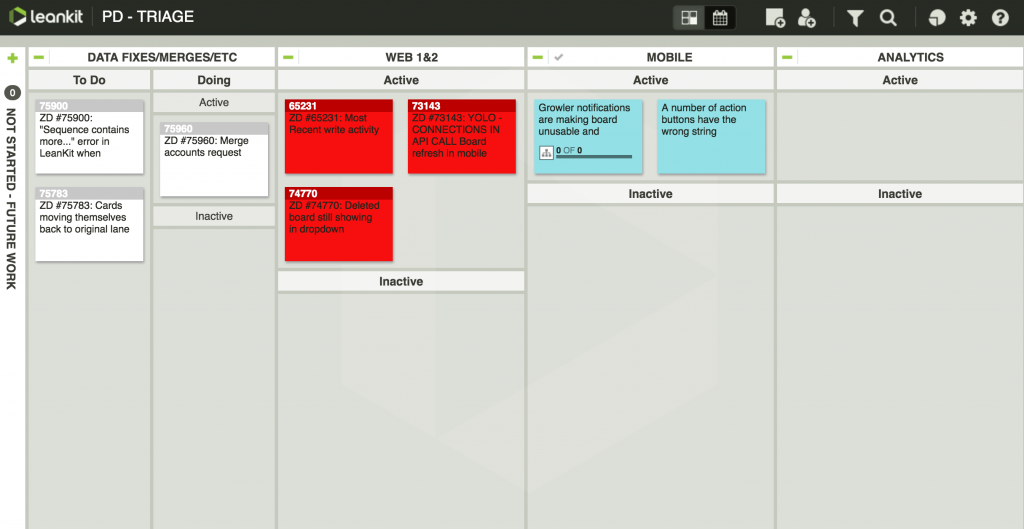
My name is Andy Hoover and I manage our Customer Support operations here at Planview AgilePlace. I spend my time making sure our amazing team of support agents has the tools, training and processes in place to help our customers with any questions or problems they run into when using Planview AgilePlace.
In this post, I’ll explain how Planview AgilePlace’s support agents use Planview AgilePlace integrations to automate part of the ticket escalation process and ensure quick, accurate resolutions for our customers.
Supporting Planview AgilePlace
Like customer support representatives elsewhere, Planview AgilePlace’s support agents spend their days “living” in their help desk tool, Zendesk. Here we work with our customers by email, chat, and phone to answer their questions and solve their problems quickly and accurately. (You can reach us at support.leankit.com if you have a question or need help with anything Planview AgilePlace.)
Our team of superb customer support agents handles a large number of contacts from customers. We respond quickly and get most issues resolved with a single interaction. But sometimes customers run into an issue which requires more specialized expertise. It might be a bug, an issue particular to one customer’s data, or a task that requires expertise or access beyond what we have on the support team. That’s when we escalate the issue.
Our escalation process works like this: When an issue comes up in Customer Support that requires more specialized expertise, the Customer Support agent escalates the issue to the QA team, who then might distribute the needed work to one of the Product Development teams. Then, when the task is completed or the bug fixed, QA confirms the fix and informs Customer Support. Customer Support then confirms with the customer that their issue is indeed resolved.
Risky Handoffs
Handing issues from one person to another, not to mention from one department to another, always risks issues falling between the cracks, slow turnaround times and miscommunication. This is especially so when the two sides of the handoff live in different tools.
Also, the mythological “multitasking” (also called task switching), which amounts to having your focus and attention shifted from one context to another, slows your progress and lowers the quality of each task you’re trying to balance. Having developers shift from one tool to another to respond to unpredictable support demands would hamper their development work, and probably wouldn’t provide the best support anyway. Our COO Jon Terry wrote a great article about task switching and other wastes that impact business growth.
Planview AgilePlace (and Zapier) to the Rescue
So, how did we solve this conundrum? We needed to give the best support we could to our customers by drawing on the expertise of the QA and Product Development teams, while at the same time not pulling developers and others out of their tool and into another. We couldn’t afford to lose information handing the issue back and forth between teams. How can we hand off things or ask for help when we live in separate tools all day? How can we avoid developers tracking work in separate apps?
We used Planview AgilePlace, of course — specifically, Planview AgilePlace integrations. Planview AgilePlace integrates nicely with a large number of other applications via Zapier, a web automation app that lets you to automate tasks between other online apps.
Using the tool Zapier, I set up a “Zap” that creates Planview AgilePlace cards from Zendesk tickets, thus connecting our support ticketing tool—Zendesk—to the tool our QA and Product Development teams use to visualize and track their work—LeanKit.
It works like this: When a ticket needs to go to the Product Development squads or QA, Planview AgilePlace support agents mark it with certain tags. Tickets marked with these tags show in a special saved view in Zendesk. The Zap we created watches for new tickets in that saved view. When a ticket first arrives there, the Zap creates a card on a “triage” board in Planview AgilePlace used by the QA and Product Development teams. The card includes the support ticket number as the card’s external card ID, a description of the issue and a link to the Zendesk ticket in the card’s description. No email, chat, shoulder tap, paper airplane, smoke signals, or other form of communication needed; thus, no confusion or delay, and no issues dropped through the cracks in a vague handoff. And no one gets their attention and focus fragmented by switching contexts or tools.

Quick and Focused Collaboration
Within minutes of the customer support agent’s decision to escalate an issue, it’s visible to the QA and development teams. From the triage board in Planview AgilePlace, the issue is evaluated by our experts in QA and routed to the appropriate development squad for resolution, if necessary. Customer-reported issues and related tasks are integrated into the flow of development work. The card created via Zapier is moved through other boards, tracking the work done by the developers. When the code fixing the issue is deployed, or the issue is otherwise resolved, a note is added to the original Zendesk ticket using a link in the card. This signals Customer Support agents to contact the customer who originally reported the issue and confirm that it is resolved.
The Planview AgilePlace card keeps the issue and its current status visible to any interested parties at Planview AgilePlace, eliminating the need for disruptive status updates or context switching.
Thanks to this process, I’ve seen this cycle—from initial customer contact, to escalation, to code deployment, to customer confirmation—completed in as little as a few hours. Resolution for a particular issue depends on the issue itself, of course (some issues require a lot more development work), but our escalation process from Zendesk into Planview AgilePlace eliminates bottlenecks and certainly speeds the process.
Planview AgilePlace developers aren’t pulled from their work into a different tool (Zendesk), and customer issues aren’t lost in hidden emails or chat threads. We make the tools do the work of moving information between the tools.
People, then Process, then Technology
Our use of Zendesk, Zapier and Planview AgilePlace works because we started with a well-defined process, then we automated parts of it using these tools. We didn’t expect the technology to fix a broken process. Automating a malfunctioning process just makes it malfunction faster and more efficiently. But, when used on top of a well-defined and accepted process, adding automation and visualization can avoid many of the pitfalls of handoffs and speed the process along to everyone’s benefit.

![A Global Collaborative Work Management Blueprint [Video]](https://blog.planview.com/wp-content/uploads/2019/07/A-Global-Collaborative-Work-management-blueprint.png)


